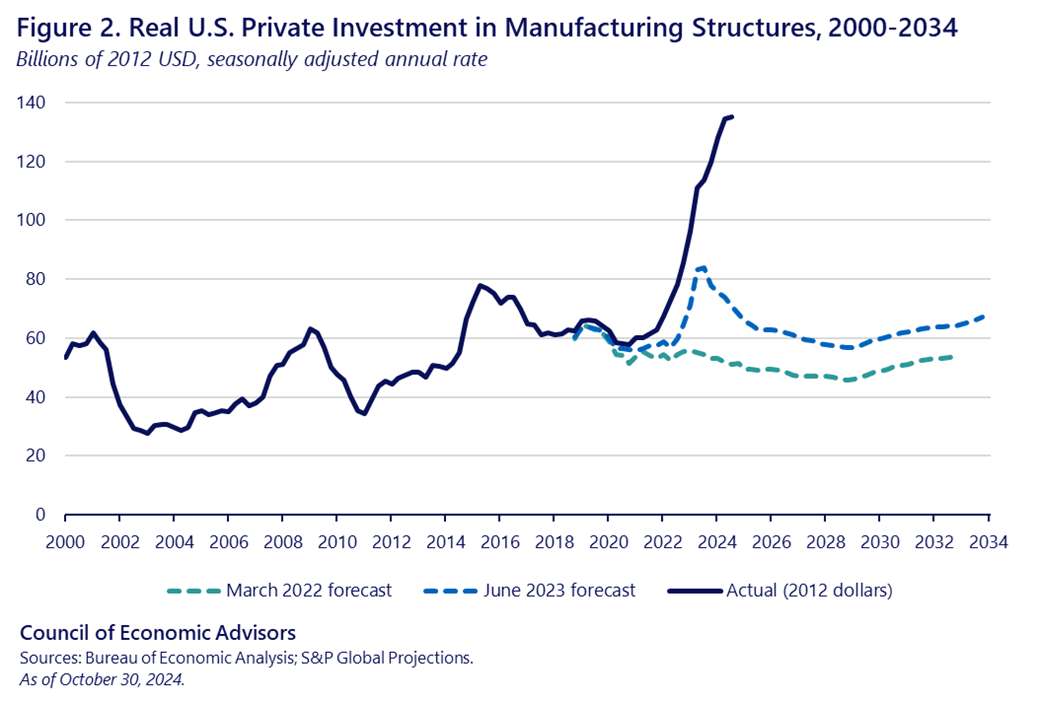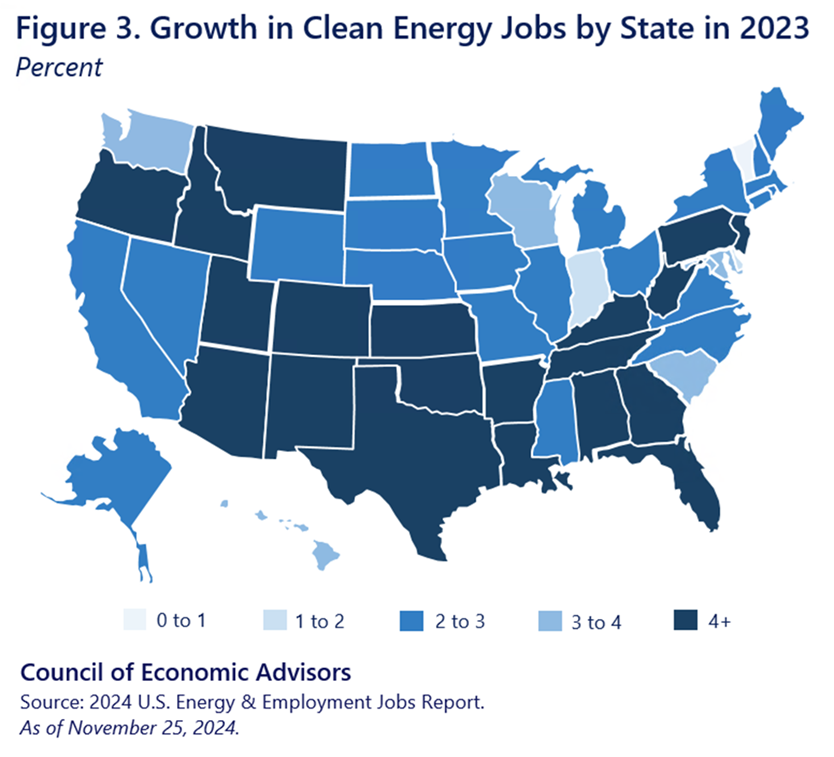The Biden-Harris Administration Has Catalyzed $1 Trillion in New U.S. Private Sector Clean Energy, Semiconductor, and Other Advanced Manufacturing Investment
Heather Boushey, Chief Economist, Investing in America Cabinet
The Biden-Harris Administration’s Investing in America agenda is making strategic public investments in American manufacturing, infrastructure, and clean energy to revitalize the nation’s manufacturing leadership, help drive steady and stable economic growth across the country, and address the climate crisis. The President’s approach revives a powerful tradition of public investment which has now positioned the United States to be competitive in key industries of the future. This government-enabled, private-sector-led approach contributed to the economy defying economist expectations and is crowding in private capital to critical sectors. New data released this week show that since President Biden and Vice President Harris took office, announcements of private sector investments in clean energy and manufacturing in the United States have now surpassed $1 trillion (Figure 1).

The landmark pieces of legislation that make up the Investing in America agenda – the Bipartisan Infrastructure Law, the CHIPS and Science Act, and the Inflation Reduction Act—were designed together and are being implemented together. They include grant and loan programs, tax credits, and other policies to catalyze private investment in the earliest stages of research and development through commercial-scale manufacturing. These investments will drive innovation and productivity that fosters American economic competitiveness and energy security, while delivering good jobs and benefitting communities across the country. They improve our nation’s infrastructure, so investing in the United States is more attractive to companies worldwide. And, they will help bring down the costs of key technologies, benefiting American workers, businesses, and families.
The Bipartisan Infrastructure Law provides billions in foundational investments in infrastructure, such as roads, highways, bridges, drinking water and wastewater systems, with $568 billion announced for over 66,000 projects so far. The CHIPS and Science Act provides $39 billion in grants and other incentives to semiconductor companies to build fabrication plants and produce cutting-edge technology in the United States—of which $34 billion worth of preliminary agreements have been announced. And the Inflation Reduction Act includes tax credits, grants, and loans to spur investment and comprehensive deployment of clean energy, including the manufacturing of battery components and critical minerals right here at home. Core to the Investing in America model is sending clear demand signals, addressing supply-side constraints, and solving coordination problems, all while strengthening and supporting Made in America domestic capacity.
This blog lays out the industrial strategy approach of the Biden-Harris Administration and how that has crowded-in private investment—especially to places that need it the most—leveraging public dollars for much-needed economic growth and the creation of good jobs.
Investment
To see how the Investing in American agenda is crowding in U.S. private sector investment in critical sectors, this blog examines two types of data: firms’ announced plans to invest and how those are being followed up by actual investment. The White House tracks private-sector announcements and their U.S. geographic location on invest.gov. The datapoints show that announced investments now total over $1 trillion. Of this total, $446 billion are for semiconductors and electronics, $91 billion for clean energy manufacturing, $182 billion for electric vehicles and batteries, $54 billion for biomanufacturing, $49 billion for heavy industry, and $188 billion for clean power. Altogether, nearly $800 billion has been announced for manufacturing projects, strengthening domestic production and creating more resilient supply chains. The invest.gov data are similar to other trackers of private announcements and investments, such as the Clean Investment Monitor, which focuses on clean technology investment and reiterates an unprecedented increase in clean energy investment since the Inflation Reduction Act was signed.
Announced investments are an indication of planned future economic activity; we still need to track when dollars actually flow into communities. While firms’ planned expenditures are not tracked in available public data, the Bureau of Economic Analysis (BEA) provides an aggregate measure of how much investment is taking place across the economy. Specifically, the BEA tracks private investment in factory construction in the United States—the most relevant indicator available to track how planned investments from invest.gov are showing up in spending.
Under the Biden-Harris Administration, real investment in factory construction has skyrocketed. Since the President and Vice-President took office, it has more than doubled, exceeding forecaster expectations from before and after the Investing in America agenda was passed (Figure 2). As of the third quarter of 2024, investment in manufacturing structures is at an all-time high and has broken record highs for the past nine quarters. The Department of the Treasury found that this investment contributed to almost one-third of real business investment growth in the same period—in stark contrast to the past 50 years, when investment in manufacturing structures contributed nearly zero percentage points to real business investment growth.

Data from other organizations that track actual investments are consistent with this trend. The Clean Investment Monitor tracks investment in clean energy technologies and infrastructure once a project breaks ground by spreading the project’s cost over the life of the reported construction period. Their most recent quarterly report shows between the second half of 2022 and the first half of 2024, actual public and private investment in clean technology and infrastructure totaled $493 billion, a 71 percent increase from the two-year period before the Inflation Reduction Act was signed. Of that, the clean energy manufacturing and transportation technology sector posted the fastest growth. This report concludes that for every $1 of federal investment, between $5 to $6 of private investment is being crowded in.
The rise in investment increased along with record-breaking new American business formation. The near four-year period under the Biden-Harris Administration saw the highest number of applications to start a new manufacturing business since the data began being collected in 2004. Previous Council of Economic Advisers (CEA) analysis suggests that these applications will translate into strong future economy activity as well as quality job creation.
Distribution
Investment is more than numbers in a spreadsheet; it happens in neighborhoods and communities across the country. The Investing in America agenda includes several programs that encourage investment in disadvantaged communities. Early indications are that this is working: a recent Department of the Treasury report shows that clean energy investments are largely taking place in counties where median incomes, graduation rates, and employment rates are below the respective national aggregate rates. For instance, 75 percent of Inflation Reduction Act related private investments are in counties whose median household income are below the national level. CEA found that foreign direct investment in clean energy manufacturing is going to areas disproportionately affected by the “China shock,” places that experienced larger declines in manufacturing employment due to increased import penetration.
Several other reports have shown similar results on investment going to lower-income regions, indicating that more-distressed U.S. communities are early beneficiaries of the Investing in America agenda. Furthermore, many clean energy projects that utilize tax incentives under the Inflation Reduction Act are expected to seek qualification for the law’s additional prevailing wage and registered apprenticeship tax incentives, meaning they can receive five times the base amount of certain clean energy tax credits and deductions. This will create opportunities for apprentices, union workers, and workers without four-year college degrees.
Employment
New public and private investment and shovels in the ground have directly resulted in a rise in employment. Construction employment is at an all-time high, and since the start of the Biden-Harris Administration, the economy has added a total of 947,000 construction jobs. Of this, 581,000 are in nonresidential construction, where monthly employment growth accelerated after the passage of the Bipartisan Infrastructure Law and grew even more following the signing of the CHIPS and Science Act and the Inflation Reduction Act, bouncing back faster than previous economic expansions. Between January 2021 and when the Bipartisan Infrastructure Law was passed, average monthly job growth in nonresidential construction was 7,000; during the year after the Inflation Reduction Act was enacted, the average jumped to 14,800 jobs created per month. Over the past six months, nonresidential construction has added an average of 15,000 jobs per month, above the 12,100 monthly average between 2017 and 2019.
As novel investment leads to new production, analysts expect manufacturing employment to increase by as much as 8 percent. CEA internal analysis indicates that it typically takes about two years from a rise in the construction of new manufacturing structures until there is an uptick in manufacturing employment. Recent data also show that in the third quarter of 2024, real investment in industrial equipment increased three percent compared to a year ago.
Turning to the clean energy sector, the latest yearly U.S. Energy and Employment report shows that under the Biden-Harris Administration, 400,000 clean energy jobs have been created. As investments are taking place across America, clean energy jobs are taking off as well. Matching the pace in 2022, data from 2023 show clean energy employment, excluding traditional energy transmission and distribution, has grown in all 50 states (Figure 3). In 2023, clean energy employment grew at twice the rate of job growth in the overall economy and, for the first time, unionization rates in clean energy jobs surpassed those of traditional energy employment, growing to 12.4 percent.

The latest Quarterly Census of Employment and Wages, which includes quarterly data through March 2024, shows that since the President took office, 33,000 power generation and supply jobs have been created. This sector previously had been in a prolonged decline, but in February 2024, the industry employed more people than at any other time in 20 years. Since the Inflation Reduction Act was passed, average weekly wages in this industry have grown 6.1 percent, 1.9 percentage points higher than inflation during the same time period.
Both the number and quality of jobs are important for workers and the overall economy. As the President’s recent Good Jobs Executive Order and White House blog underscore, the Investing in America agenda is deliberate about empowering workers with well-paying jobs, especially union jobs. These good jobs with higher compensation and safety standards in turn reduce turnover and increase productivity, benefitting workers, employers, and the overall economy.
Conclusion
President Biden and Vice President Harris came into office with a plan to restore American leadership at home and abroad, and grow the economy from the middle-out and bottom-up. To realize that bold vision, they put in place the Invest in America agenda, implementing a government-enabled, private-sector led approach that is producing tangible results for communities and businesses in every corner of the United States. With $1 trillion in new private sector investment announcements, the Biden-Harris Administration’s agenda can continue to promote inclusive economic growth in places all across the country for decades to come.
